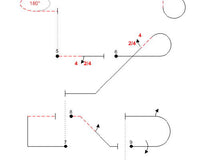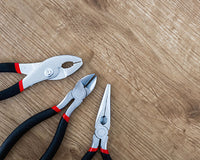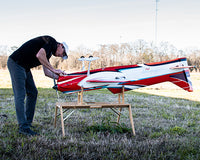This article is written by CK Aero Co-Founder Brett Wickizer during preparation for the 2015 F3A World Championship
Ooph, that’s a good question. I’m not sure I know the full answer to that question yet. If I did I would probably be World Champion. That’s part of competition, always striving to make yourself better, always looking for that next little leg up. Bryan and I never stop pushing for better.
"Bryan and I never stop pushing for better."
You have to think ahead and plan ahead. Bryan and I have already started preparing for the 2017 World Championship and we can’t even be sure we’ll actually make the team. I already know what airplane(s) I’ll be flying for the team trials and for the 2017 World Championship itself, assuming we make the team. If your preparation isn’t thinking 2 years ahead of where you’re at you are already behind. There is an incredible amount of forethought that goes into this if you want to make a credible shot at the top 10 in the World Championships. Planning and forethought — that’s what it takes to prepare for a World Championship. But is that the whole story? No, I don’t think so.
It also takes an incredible amount of dedication. Our lives have to cater to this strange obsession that we have (Bryan recently mentioned a quote that he read, “Obsession is just the word the lazy use to describe the dedicated”, and we shared a self-aware chuckle). Bryan gets home from his full time job, works in the shop until 1 AM, then wakes up at 6 AM and does it all again! I’m pretty sure he is some sort of alien android. My other pursuits, finishing my degree and starting my career as a full scale pilot chief among them, have kept me from pattern more than I’d like. The only way that I’m able to continue at the level that I do is because of the dedication of Bryan. This doesn’t mean that I’m not working as hard as I can either, though. This past year I would wake up at 6:30AM to go to work, work until 2PM or 4PM depending on my schedule, then drive to the flying field and practice until 8:30 in the evening, drive an hour back to my home, and do it all again. Oh, and eat, at some point…
"It also takes an incredible amount of dedication..."
"Are you prepared to embrace that inconvenience?"
Did I mention it’s the middle of the Florida summer, or that the flying field I practice at has no shade, no running water, and no bathroom? All of those amenities are second to the fact that I can go to that field and be by myself all day long. That’s my only criteria, the number of flights I can have in solitude. Are you prepared to embrace that inconvenience? Are you prepared to make your job second to flying model airplanes? Are you prepared to work long hours after you just got done working long hours?
I think a lot of people might stop there if they were making a list of what it takes to be great. That’s the American ideal. Think ahead, work as hard as you can, and life will work itself out. However, I can think of people that do those very things and never make the world team. So what’s the secret ingredient? Where is the magic?
That is the million dollar question and I’m still looking for the complete answer. Part of that magic is natural talent. Without a doubt, the top 10 spots at the world championship is filled with pilots just oozing natural talent. Again, I think a lot of people might stop there, but I believe that while natural talent is absolutely necessary, it’s just a small part of the equation. Just a few years ago there was an immensely talented pilot that hadn’t flown much pattern and tried to make the world team. Many thought, because of his incredible natural talent, that he was a shoe-in. But I don’t think he had the rest of the magic. I seem to remember him saying something to the effect of “I don’t get it” as he exited the pattern world, and therein lies a lot of the answer.
You have to "get it"
“Getting” F3A means understanding all of the factors that contribute to why that judge gave you a 5 on that split S (if you think that’s a joke I’ve got some scoresheets I’d like to show you). Once you understand those factors you can work to influence everything that you can. That understanding, for a lot of people, stops at an evaluation of the judge. If you spend any time judging your judges, you do not have what it takes. That doesn’t mean we don’t spend any time assessing the realities of some biases, but it does mean that we don’t dwell on those biases and use them as excuses for our own shortcomings. That mindset pervades pattern and is the number 1 reason, in my opinion, that pilots stop advancing. It’s so easy to blame somebody else for your bad scores, especially when real biases exist, but as soon as that happens you give up your power to affect positive change. Sounds like some sort of motivational self help, right? Competition has a beautiful way of reflecting life’s difficulties and manifesting truths about character.
I could wax poetic for hours on the subject. Suffice it to say that “getting” F3A is more complicated than meets the eye.
These past two weeks I’ve been lucky enough to have the opportunity to practice full time for Switzerland. My job as a flight instructor is very demanding on my time while I’m working, but the upshot is my ability to take off an extended period of time like I am right now. I’m taking 5 weeks off of work for the preparation and participation in this event. That has given great clarity and focus to my preparation in a way that I’ve never had. In addition, my thinking has matured and I’m able to use the time much more wisely. I kept a diary each day about my impressions of how the airplane was flying so I could log my thoughts in a manner in which they would be easy to retrieve later. I’ve never been a prolific writer or note taker but the process of writing down what popped into my head has proven to be extremely useful. I now have notes that I can study on the airplane to Switzerland — a personalized study guide of sorts. An 11 page, single spaced word document with narrow margins isn’t quite a “study guide” as much as it is a short novel but it’s very useful nonetheless :). I think there is value in seeing some of the things that I wrote down.
In addition to notes about flying I often wrote down things that kept me positive and helped me keep perspective, something I’ve realized is crucial to be mentally and emotionally ready for something as personally taxing as a world level competition. It’s also crucial to a healthy life. The two tend to go hand in hand. I ended my first diary entry with this:
“Final thought – I get to do this full time for the next two weeks! Are you kidding me? Living literally every pattern competitors dream right now. That’s badass. So lucky and grateful and excited to take advantage of that.”
Indeed, pretty badass. Still loving it.
Something else that made the diary useful was the ability to look at the details of the airplane’s behavior and come to larger conclusions. The more you can simplify deficiencies down to a common denominator the more deficiencies you can fix. I wrote this after mentally replaying several flights with the airplane.
“I have to respect the Alferma when I fly it. I don’t know how else to express that, but the airplane will absolutely bite you in the ass if you don’t respect what you’re doing with it. Respect it, and it will respect you. It’s like a pure race car. You wouldn’t drive it on the streets but it’s an incredible tool if you know how to wield it.”
I’ve found that if I can pare down concepts to myself in ways that I would teach it to somebody else it enables me to understand it much better. I think that is something that anybody who teaches for a living understands intimately. My training and experience as a flight instructor taught me that lesson.
In addition to big conclusions I had innumerable notes about mistakes that I made or behaviors the airplane was exhibiting on certain maneuvers and how to try and fix them.
“The golf ball requires a strong attention to geometry the whole time I’m doing the maneuver. Paying attention to rolls on the middle of lines and roundness of the loop leads to the maneuver being a success.”
“The half square on corner is OK but unrefined. My roll on the top portion needs to be crisp but graceful and I’m having trouble balancing that with the low airspeed on that leg. Extend first leg and use more power on second leg?”
In some spots I went into a lot of detail
“Good progress on the double Immelmann today. Second half of the first integrated portion I need to think of using a constant amount of down elevator, this produces a nice radius on that top half. For the entry I need to think about pulling up elevator before I start rolling juuuust slightly and making sure I get to the vertical point right at 90 degrees of roll. Need to work on the 2 of 4 on top and on the bottom – can’t quite nail down a good roll rate and presentation. Haven’t felt the balance there yet. My inclination is that I’m rolling too slow without enough definition. The second integrated portion is interesting and altogether more difficult. What I found is to get off the power relatively early and right at the beginning of that integrated portion it’s just a matter of barely letting the airplane fall, like setting it down on a soft pillow. At the same time just ever so slightly rolling and getting into the rudder at about 45-60 degrees through that second half loop. On the bottom half of that loop, when I start to reintroduce the down elevator, it’s a steady, increasing amount of down elevator to keep that portion round.”
And most importantly, if you decide to diary yourself, don’t take yourself too seriously 😉
“Top hat is looking killer, kudos brah. That 2 of 4 up was a total let down but you totally slayed it with that elevator adjustment. Downline snap is on point.”
If you have any questions about anything I love to talk about this stuff! Feel free to shoot me an email at BrettWickizer@gmail.com












